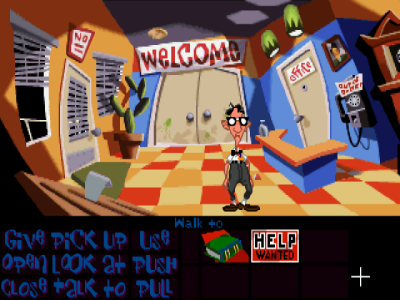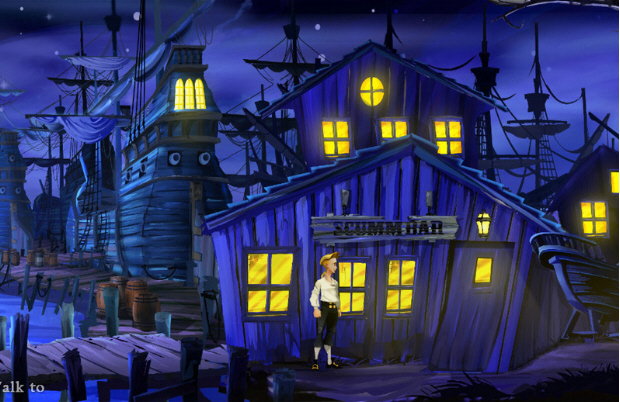‘The Macintosh uses an experimental pointing device called a 'mouse.' There is no evidence that people want to use these things.’ – John C Dvorak
In the early eighties, computer hardware was rapidly improving. Graphical displays with many colours were finally a possibility and this captured the imagination of developers of text based adventure games such as Sierra (now owned by Activision Blizzard). Meanwhile, in 1984, Apple released a new machine named the Macintosh with a groundbreaking point and click device known as the mouse. Developers began to experiment with a more visual and interactive way of delivering their narrative games and Point and Click adventure games were born as a result of this experimentation.
Before conventional point and click adventures were established, there were earlier graphic and text hybrid games. One example of such is Enchanted Scepters (Silicon Beach, 1984) which featured a text parser at the side of the screen, containing a description of the room the player was in. This was innovative due to the fact that it was the first game which required the player to actually click on items to interact with them.
‘Déjà Vu’ (ICOM, 1985) is usually credited as the first full point and click game with no text parser included. This title was set in Chicago in the forties and you took on the role of Ace Harding, a private eye who wakes up in a bathroom with holes in his memory. The game was well received and critically acclaimed, being ported to many systems including the NES, Windows and finally the Game Boy Colour with a sequel in the early nineties.
In 1987, ‘Maniac Mansion’ (Lucasarts, 1987) was released for DOS. This was Lucasarts first real foray into the newly established genre and the title garnered glowing reviews from players thanks to early innovations such as multiple possible endings. This title established the first version of the SCUMM (Script Creation Utility for Maniac Mansion) engine, one of the most popular and ubiquitous. This engine was later used for many subsequent Lucasarts point and click adventures released in the late eighties to and nineties, of which a high percentage were highly successful.
‘How appropriate, you fight like a cow.’ – Guybrush Ulysses Threepwood
Notable releases included ‘The Secret of Monkey Island’ (Lucasarts, 1990), ‘Monkey Island 2: LeChuck's Revenge’ (Lucasarts, 1991), ‘Sam and Max Hit the Road’ (Lucasarts, 1993), ‘Day of the Tentacle’ (Lucasarts, 1993), and ‘The Curse of Monkey Island’ (Lucasarts, 1997).
Many of the Monkey Island titles featured running gags relating to things as obscure and diverse as porcelain, rubber chickens and insult sword-fighting. Also noteworthy, the main character Guybrush Threepwood would at times break down the fourth wall and talk to the player, or refer to sequels and other Lucasarts games being made in in-game dialogue. This was quite unusual at the time as most adventure games were based around suspending the disbelief of the player.
Arguably the final swansong of the 2D point and click scene, ‘The Curse of Monkey Island’ was a highly polished adventure featuring beautifully stylistic graphics, distinctive music, animated cutscenes and full voice acting for every character. The game, now considered by many to be a classic, received widespread acclaim on its release and to this day maintains a metacritic score of 89%. Adrenaline Vault stated that "The twin vitals of an adventure game are a good plot coupled with strong dialogue. This game has both, in spades."
‘Death makes sad stories of us all.’ – Membrillo the Morgue Attendant
However the genre was never really allowed to enjoy its maturity in the same way many other established genres were. The goalposts were effectively moved by the release of Grim Fandango (Lucasarts, 1998) which introduced the world of puzzle solving adventure games to the world of 3D graphics with great style. Set in an Aztec/Mexican/Film Noir afterlife with memorable characters, strong voice actors and a perfectly envisioned Jazz and Swing soundtrack, this step effectively made Lucasarts both the architects and executioners of the 2d genre. Despite widely being regarded as a commercial failure, over the years it has become generally viewed as a highly influential and groundbreaking game, setting a precedent which almost every other commercial adventure game then followed. Thus, the 2d genre commercially petered out, only to be kept alive by hobbyists found on the net, in places such as the SCUMMvm community where developers have gone so far as to write their own adventure games from scratch using the old Lucasarts engine.
“Good luck, agent Calavera. Viva la Revolución.” – Salvador Limones
After an extremely quiet period for point and click adventures, July 2009 heralded the re-release of a special edition of ‘The Secret of Monkey Island’ on PC, iPod and Xbox Live. The game was well received and scored 86% on metacritic. While being essentially the same game as the 1990 original, this version features a completely hand redrawn graphical interface, including backdrops, items and characters, all updated for display in full 1080p high definition. In addition to this, the game features full CD quality re-recorded background music and features the original cast of voice actors from ‘The Curse of Monkey Island’, including Dominic Armato reprising his role as Guybrush. Although these assets are now in the game, the original experience can be accessed with a hotkey, which switches the music back to the MIDI originals, removes the voiceover and returns the display to VGA-style 1990 graphics.
The encouraging reception this remake received nearly twenty years after the original release seems to suggest that there may still be hope for the genre if the games are fuelled by a strong story, good characterisation and polished assets in the same way as ‘The Curse of Monkey Island’ and ‘The Secret of Monkey Island: Special Edition’.









A pirate I was meant to be! Nice post Matt.
ReplyDeleteWhat a fantastic article! I know nothing about any of this stuff but I was totally into this article. Well done, Matt. You could be writing for some type of games magazine, surely!
ReplyDelete